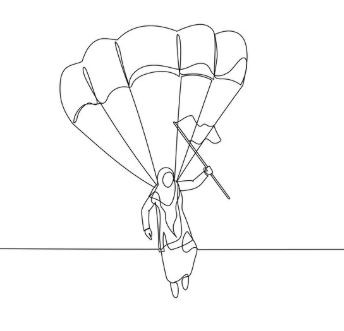Do you crave risk or prefer safety in trading? Discover how your personality shapes your trading style and how to align both for long-term success.
Let me ask you a simple question:
How would you prefer to spend your weekend — skydiving or strolling through a museum?
Now, this isn’t about thrill-seeking or being boring. It’s actually a reflection of your core personality. And interestingly, it might just reveal the type of trading personality you have.

Most people assume that if you’re a short-term trader, you’re naturally a risk-taker — someone who lives for the adrenaline rush. And if you prefer long-term investing, you’re cautious and methodical. But life isn’t so black and white. Maybe you’re a skydiver who also loves spreadsheets. Or a quiet museum-goer who thrives in fast-paced decisions.
The truth is: Your personality plays a huge role in your trading success.
But here’s the twist — your trading style should fit your personality, not the other way around.
Let’s explore how your mindset, upbringing, and emotional tendencies shape your risk tolerance in trading — and how to find the trading style that truly suits you.
🎭 Your Trading Personality: Nature, Nurture, and Now
Some of us have been wired since childhood to either fear uncertainty or chase it.
- Maybe you were the kid who always raised their hand first, eager to try something new.
- Or maybe you stayed in your comfort zone, waiting until things felt “safe” before jumping in.
These tendencies don’t just vanish in adulthood. In fact, when it comes to something as emotionally intense as trading, they can get amplified.
“Under stress, we don’t rise to the level of our expectations. We fall to the level of our training — or our temperament.”
Let’s break this down.
👶 How Childhood Shapes Risk Tolerance in Trading
Your early environment affects your emotional response to risk:
- Supportive Parenting? You may feel confident exploring markets.
- Unpredictable or Emotionally Absent Upbringing? You might become anxious when outcomes are uncertain — like during market volatility.
But that doesn’t mean you’re doomed to be risk-averse or reckless.
Awareness is your superpower.
⚖️ Risk-Taker or Safety-Seeker: Which One Are You?
Ask yourself:
- Do you get excited watching fast-moving charts?
- Or do you prefer the calm of checking your investments monthly?
Here’s a quick contrast:
| Trait | Risk-Taker | Safety-Seeker |
| Enjoys Volatility | ✅ | ❌ |
| Impulsive Entry/Exit | ✅ | ❌ |
| Loves Short-Term Trading | ✅ | ❌ |
| Gets Anxious During Losses | ❌ | ✅ |
| Sticks to Plans Religiously | ❌ | ✅ |
| Long-Term Vision | ❌ | ✅ |
Most traders fall somewhere in between. And that’s okay — as long as you don’t lie to yourself about who you are.
“In trading, self-deception is more dangerous than market deception.”
📈 How to Match Your Trading Style to Your Personality
Once you understand your trading personality, you can align it with a style that reduces internal conflict.
For Risk-Takers 🔥
You might enjoy:
- Scalping or intraday trading
- Momentum or breakout strategies
- Quick decisions, tight stop losses, fast reward
But beware:
- Overtrading
- Ignoring plans when adrenaline kicks in
- Revenge trading after losses
For Safety-Seekers 🧘
You might prefer:
- Swing trading with clear patterns
- Long-term investing with value stocks
- Limited exposure, more planning, less noise
But beware:
- Paralysis by analysis
- Avoiding trades out of fear
- Over-reliance on “certainty”
🎯 Mentor Tip: Choose strategies that feel like home — not ones that impress others.
🛡️ How to Manage Risk Without Killing Opportunity
Whether you’re a daredevil or a data nerd, risk is part of the game. But unmanaged risk becomes stress.
Here’s how to minimize emotional overwhelm:
🧰 Risk Management Checklist:
- ✅ Use protective stop-loss orders
- ✅ Pre-define max loss per trade (e.g., 1–2% of capital)
- ✅ Journal your emotions after every trade
- ✅ Review past trades based on process, not outcome
- ✅ Never increase position size out of frustration
💡 Mindset Shift: Stress Doesn’t Reveal Weakness — It Reveals Your Defaults
If you suddenly find yourself panic-selling or hesitating to enter a setup, it may not be about that trade. It’s about your deep-rooted risk personality surfacing under stress.
“You don’t decide your trading personality. You discover it.”
So instead of fighting your instincts — work with them. Design a trading system that lets you perform your best without triggering fear or impulse.
🧠 What You Should Remember
- Your trading personality is influenced by both childhood and adult experiences.
- Being a risk-taker or security-seeker doesn’t determine success — alignment does.
- Match your trading style to your emotional bandwidth, not just your ambitions.
- Use tools and routines that protect you from your own psychological blind spots.
Over time, experience reprograms emotion. The more you trade mindfully, the more adaptive you become.
📣 Call to Action
💬 What’s your trading personality — a thrill-seeking skydiver or a methodical museum explorer?
Comment below and share how your personality affects your trades.
👉 Tag a friend who’s still trying to “force fit” into the wrong trading style.

Is being risk-averse a bad thing in trading?
No, as long as your trading style fits your risk tolerance. Many successful traders are conservative by nature.
Can I change my trading personality over time?
Yes, with experience and emotional work, you can train yourself to manage risk better and adapt your behavior.
What is a trading personality?
Your trading personality is your emotional and psychological response to risk, uncertainty, and financial pressure.
How do I know if I’m a risk-taker or a safety-seeker?
Look at your past financial decisions, emotional reactions under stress, and how you handle uncertainty.
What’s the best trading style for beginners?
Start with low-risk swing trading or long-term investing, then gradually test shorter timeframes as you gain control over emotions.